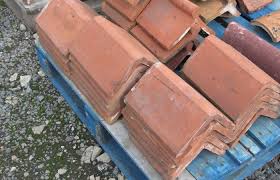25 Important Parts of a Roof
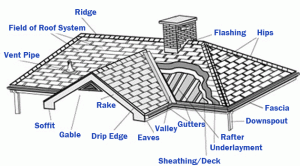
1.Ridge Board:
Horizontal metal or timber is one of the parts of a roof and resting at the peak of the roof. The trusses and rafters are connected to the ridge board for a cohesive framework.
2.Solid Decking:
A composite decking made of solid materials, steel and wooden concrete, etc., sold decking resembles natural wood and is remarkably stable and robust for bearing a heavy load.

3.Felt Underlayment:
Felt Underlayment is a waterproofing layer made of regular felt, stacked above the solid decking board, and then completely covered by the bajri, sand, or other roofing materials.
4.Shingles(bajri):
Roof covering is typical of rectangular shapes and flat and made of various materials such as wood, flagstone, plastic, metal, slate, and composite materials.
5.Vent Pipe Flashing:
An external installation on the roof uses the vent pipe system to prevent damage and water seeping in.
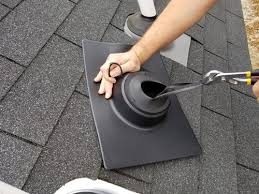
6.Skylight:
A window was installed on the ceiling or roof to daylight entered the room.
7.Chimney Flashing:
A waterproofing seal was installed at the intersection of the roof used to prevent moisture penetration and chimney.
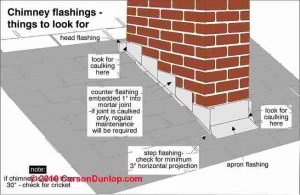
8.Chimney:
A vertical structure through the roof that ventilates combustion gases and smoke from a fireplace, stove, or boiler to the outside atmosphere.
9.Collar Beam:
The Collar beam is a horizontal beam connecting two rafters that intersect at the ridge.
10.Rafter:
One of a series of diagonal members of the truss that meet at the apex to support its loads and roof deck.
11.Valley Flashing:
Valley is flashing a waterproofing seal installed along the roof’s valley line.
12.Valley Underlayment:
Valley underlayment A waterproofing layer that protects the roof valleys from leaking.
13.Spaced Sheathing:
It is Also called Skipped Decking; spaced sheathing refers to installing the flat panels by spaces apart and results in a ladder-type appearance.
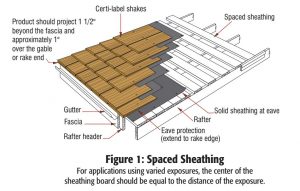
14.Fascia:
Fascia is a wood plank that runs horizontally along the roof’s edges. Fascia nailed to the rafters and may also support the gutter. The accessory also helps to enhance the property’s value and beauty.
15.Lookout:
Lookout is a horizontal joist projecting in a cantilever from the wall plate.
16.Rake:
It is an inclined side of a gable end.
17.Gutter:
A pipe for a water discharge system for a building.
18.Downspout:
The downspout is a channel that transports rainwater from the gutter. Downspout pipe running vertically from the roof to the ground. The downspout is connected to the channels and drains the water to the designated point. Downspout made of metal such as plastic, galvanized steel, and other materials.
19.Splash Block:
Splash block was found below the downspout and used to transport the rainwater from the gutter away from the house.
20.Eaves:
Eaves The lowest point of a pitched roof, including gambrel, gable, mansard, and other roofs, are known as the eave. Eaves also where the gutter is connected to the ceiling.
21.Valley:
Valley connection between two pitched and sloped roofs and forms a right angle of 90 degrees.
22.Sheathing:
The sheathing is plywood, OSB, or particleboard that is placed over the rafters. Sheathing strengthens the roof and also supports the underlayments.
23.Truss:
The truss is the framework found in the entire roof section. A truss consists of many pieces such as ridge rafters, rafters and supports, covering, insulation, sheathing, and underlayment.
24.Covering:
The covering is nailed to the rafters and dirt, stopping rain, sun, wind, snow, animal droppings, dust, and other debris from entering. Tiles, concrete, Iron sheets, slate are the popular covering materials.
25.Ridge:
This is found on a pitched, mansard, gambrel, gable, and other types of roofs. Ridge the highest point and connects the two sides of the top.
26.Ridge tile:
Ridge is the tiles or covering that is found on the ridge. Ridge prevents the entry of dirt, water, moisture, dust, and other debris.
